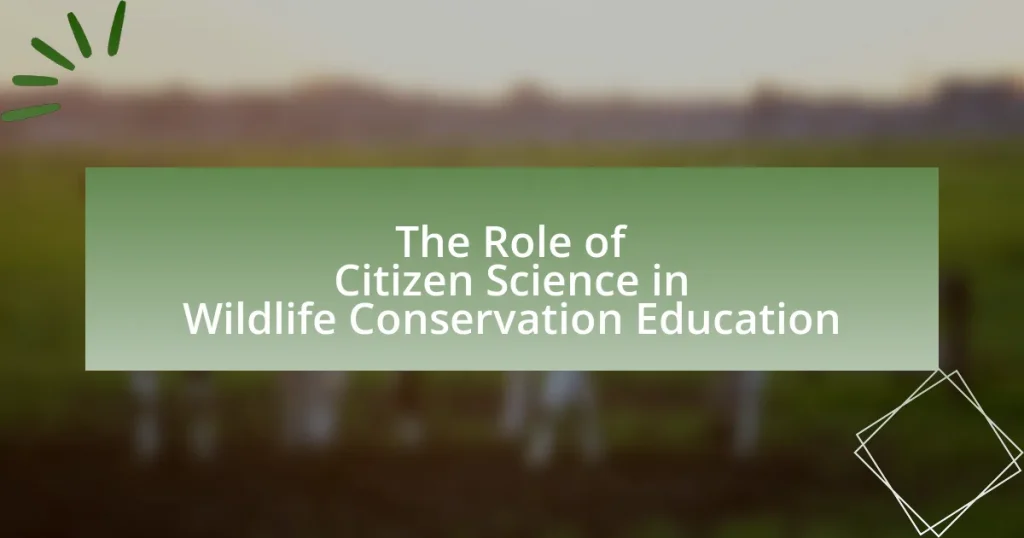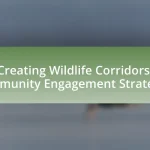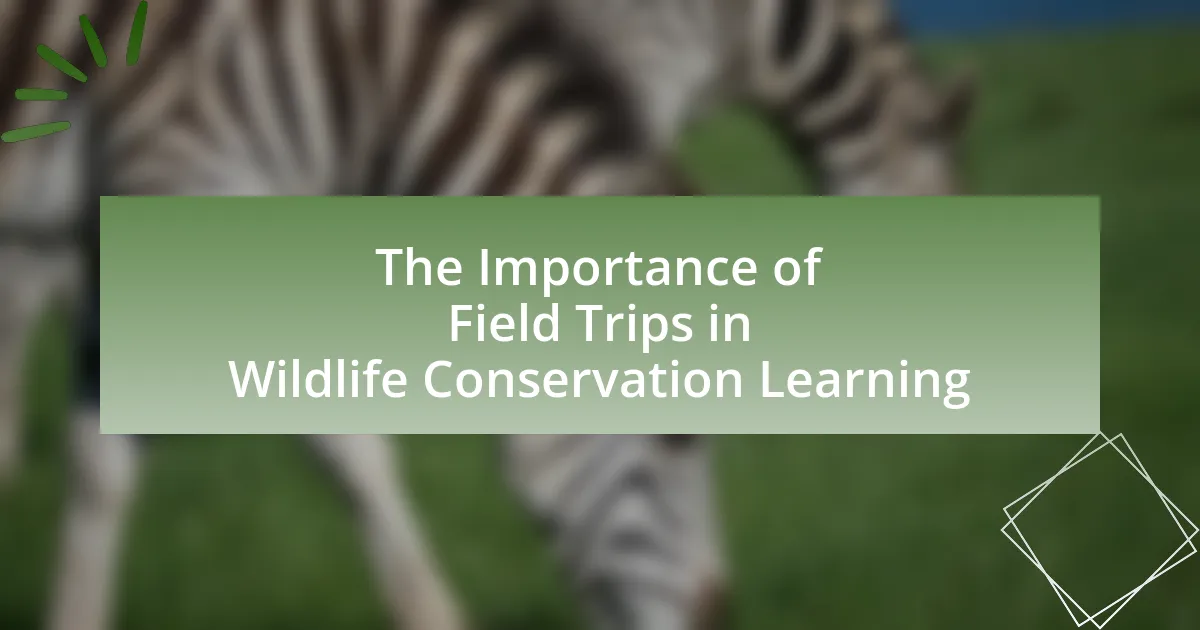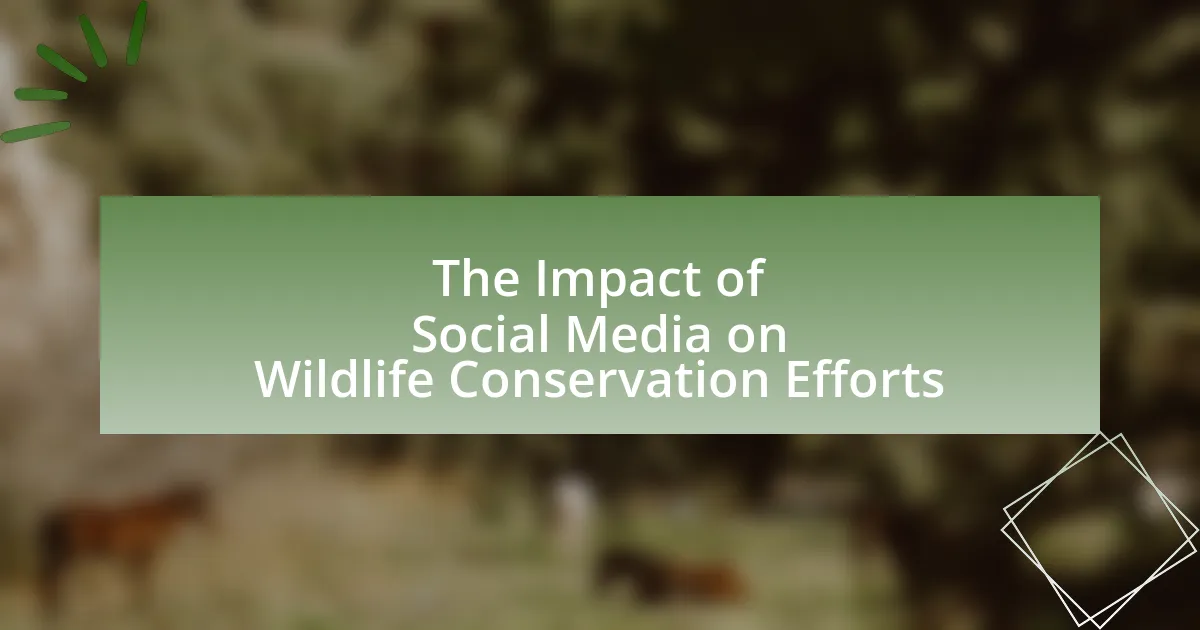Citizen science is a vital component of wildlife conservation education, engaging the public in data collection and monitoring efforts that enhance awareness of biodiversity issues. This participatory approach empowers individuals, fosters stewardship, and contributes to scientific research, as evidenced by successful initiatives like the Audubon Society’s Christmas Bird Count and the Cornell Lab of Ornithology’s eBird project. Key principles of citizen science include collaboration, data collection, and public engagement, which collectively improve conservation strategies and community involvement. The article explores the role of education in promoting wildlife conservation, the benefits of integrating citizen science into educational programs, and the challenges faced in ensuring data quality and participant engagement. Additionally, it highlights successful examples and practical steps for individuals to get involved in citizen science initiatives.
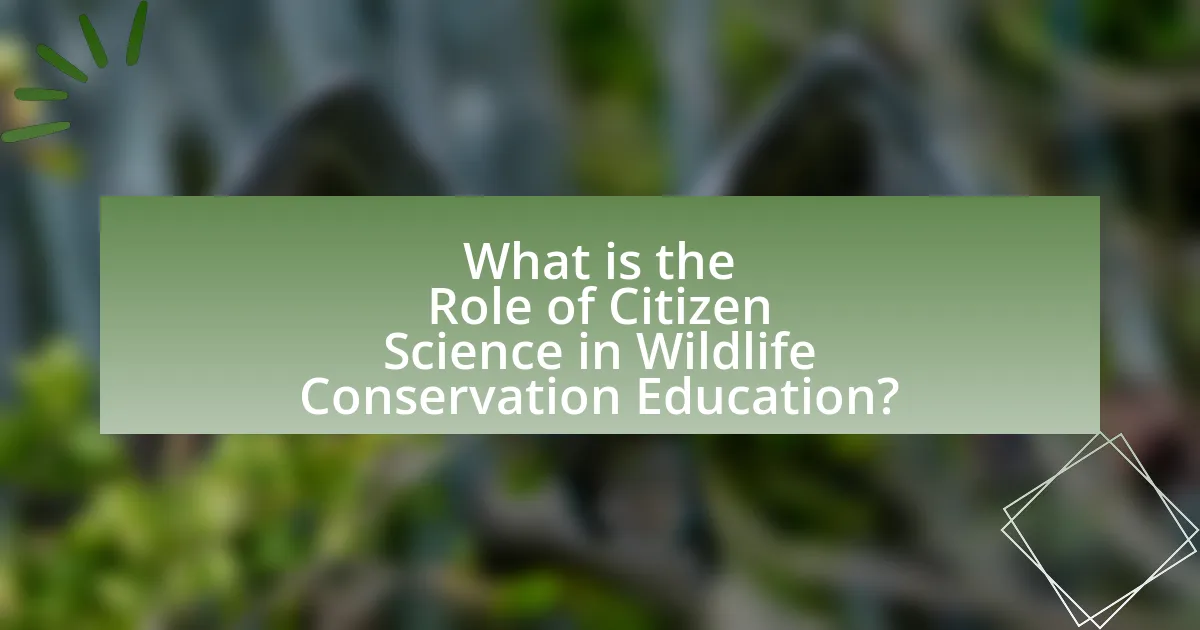
What is the Role of Citizen Science in Wildlife Conservation Education?
Citizen science plays a crucial role in wildlife conservation education by engaging the public in data collection and monitoring efforts, which enhances awareness and understanding of biodiversity issues. This participatory approach not only empowers individuals to contribute to scientific research but also fosters a sense of stewardship towards wildlife and natural habitats. Studies, such as those published in the journal “Conservation Biology,” demonstrate that citizen science initiatives can lead to increased public interest in conservation topics, resulting in more informed communities and stronger advocacy for wildlife protection.
How does citizen science contribute to wildlife conservation efforts?
Citizen science significantly contributes to wildlife conservation efforts by engaging the public in data collection and monitoring, which enhances research capabilities and informs conservation strategies. For instance, initiatives like the Audubon Society’s Christmas Bird Count involve thousands of volunteers who gather data on bird populations, providing critical insights into species trends and habitat health. This collective effort not only increases the volume of data available for scientific analysis but also raises awareness and fosters a sense of stewardship among participants, ultimately leading to more effective conservation actions.
What are the key principles of citizen science in this context?
The key principles of citizen science in the context of wildlife conservation education include collaboration, data collection, and public engagement. Collaboration involves partnerships between scientists and community members, allowing for shared knowledge and resources. Data collection emphasizes the importance of gathering reliable information from non-professionals, which can contribute to scientific research and conservation efforts. Public engagement focuses on educating and involving citizens in conservation activities, fostering a sense of stewardship and responsibility towards wildlife. These principles are essential for enhancing the effectiveness of conservation initiatives and promoting sustainable practices within communities.
How does citizen science enhance data collection for wildlife conservation?
Citizen science enhances data collection for wildlife conservation by engaging the public in systematic observation and reporting of wildlife data. This collaborative approach significantly increases the volume and diversity of data collected, as thousands of volunteers contribute observations from various geographic locations and ecosystems. For instance, projects like the Cornell Lab of Ornithology’s eBird platform have amassed over 1 billion bird observations, providing critical insights into species distribution and population trends. Such extensive datasets enable researchers to identify conservation priorities and monitor the effectiveness of conservation strategies, ultimately leading to more informed decision-making in wildlife management.
Why is education a critical component of wildlife conservation?
Education is a critical component of wildlife conservation because it fosters awareness and understanding of ecological issues, leading to informed decision-making and behavioral changes. By educating communities about the importance of biodiversity and the threats facing wildlife, individuals are more likely to engage in conservation efforts. Research indicates that educational programs can significantly increase public support for conservation initiatives; for example, a study published in the journal “Conservation Biology” found that participants in wildlife education programs demonstrated a 40% increase in conservation-related behaviors. This evidence underscores the essential role of education in empowering individuals to contribute to wildlife conservation effectively.
How does education influence public awareness of wildlife issues?
Education significantly enhances public awareness of wildlife issues by providing individuals with knowledge about ecosystems, species, and conservation challenges. This knowledge empowers people to understand the importance of biodiversity and the impact of human activities on wildlife. For instance, educational programs that incorporate citizen science initiatives, such as monitoring local wildlife populations, have been shown to increase engagement and awareness among participants. Research indicates that individuals who participate in such programs are more likely to advocate for conservation efforts and support policies aimed at protecting wildlife habitats. This correlation between education and heightened awareness is supported by studies demonstrating that informed communities are more proactive in addressing environmental issues, leading to improved conservation outcomes.
What role does citizen science play in educating communities about wildlife conservation?
Citizen science plays a crucial role in educating communities about wildlife conservation by actively involving individuals in data collection and research efforts. This engagement fosters a deeper understanding of local ecosystems and the importance of biodiversity. For instance, projects like the Audubon Society’s Christmas Bird Count have demonstrated that community participation not only enhances scientific data but also raises awareness about species conservation and habitat protection. Studies indicate that participants in citizen science projects often report increased knowledge about wildlife and a greater commitment to conservation efforts, highlighting the effectiveness of this approach in community education.
What are the benefits of integrating citizen science into wildlife conservation education?
Integrating citizen science into wildlife conservation education enhances public engagement and fosters a deeper understanding of ecological issues. This approach allows individuals to actively participate in data collection and analysis, which increases their investment in conservation efforts. Research indicates that citizen science projects can lead to improved scientific literacy, as participants learn about biodiversity and ecosystem dynamics through hands-on experience. Additionally, studies show that involving communities in conservation initiatives can result in more effective and sustainable management practices, as local knowledge and perspectives are incorporated into decision-making processes. For example, a study published in the journal “Biological Conservation” found that citizen science initiatives significantly increased species monitoring efforts and contributed valuable data to conservation strategies.
How does citizen science foster community engagement in conservation efforts?
Citizen science fosters community engagement in conservation efforts by actively involving local residents in data collection and monitoring activities, which enhances their connection to the environment. This participatory approach empowers individuals to contribute to scientific research, leading to increased awareness and understanding of local ecological issues. For instance, projects like the Audubon Society’s Christmas Bird Count engage thousands of volunteers annually, resulting in valuable data that informs conservation strategies and strengthens community ties. Such initiatives not only promote environmental stewardship but also create a sense of ownership among participants, ultimately driving collective action for conservation.
What skills do participants gain through citizen science initiatives?
Participants in citizen science initiatives gain skills such as data collection, analysis, and critical thinking. These skills are developed through hands-on involvement in scientific research, where participants learn to gather and interpret data related to wildlife conservation. For instance, a study published in the journal “Citizen Science: Theory and Practice” by Bonney et al. (2014) highlights that participants enhance their observational skills and learn to use scientific tools and methodologies effectively. Additionally, participants often improve their communication skills by collaborating with scientists and sharing findings with the community, further reinforcing their understanding of scientific processes and conservation efforts.
How can citizen science projects be effectively implemented in wildlife conservation education?
Citizen science projects can be effectively implemented in wildlife conservation education by integrating community involvement, providing accessible training, and utilizing technology for data collection. Engaging local communities fosters a sense of ownership and responsibility towards wildlife, as seen in projects like the Great Backyard Bird Count, which has successfully mobilized thousands of participants to monitor bird populations. Accessible training ensures that participants understand scientific methods and data collection techniques, enhancing the quality of contributions. Furthermore, leveraging technology, such as mobile apps for reporting sightings, streamlines data collection and analysis, making participation easier and more efficient. These strategies collectively enhance the educational impact of citizen science in wildlife conservation.
What are the best practices for designing citizen science projects?
The best practices for designing citizen science projects include clearly defining project goals, engaging participants effectively, ensuring data quality, and providing adequate training and resources. Clearly defined goals help participants understand the purpose and expected outcomes, which enhances motivation and commitment. Engaging participants through interactive platforms and community involvement fosters a sense of ownership and encourages sustained participation. Ensuring data quality involves implementing standardized protocols and regular monitoring to maintain the integrity of the data collected. Providing training and resources equips participants with the necessary skills and knowledge to contribute effectively, which has been shown to improve project outcomes and participant satisfaction. These practices are supported by research indicating that well-structured citizen science projects yield more reliable data and higher participant retention rates.
How can technology enhance citizen science participation in wildlife conservation?
Technology can enhance citizen science participation in wildlife conservation by providing accessible platforms for data collection, analysis, and sharing. Mobile applications and online databases enable individuals to easily report wildlife sightings, contributing valuable data to conservation efforts. For instance, platforms like iNaturalist allow users to upload photos and receive identification assistance, fostering community engagement and collaboration among citizen scientists. Additionally, remote sensing technologies, such as drones and satellite imagery, facilitate large-scale monitoring of wildlife habitats, making it easier for participants to contribute to conservation projects. Research indicates that technology-driven citizen science initiatives can significantly increase public involvement and data quality, as seen in studies published by the National Academies of Sciences, Engineering, and Medicine, which highlight the effectiveness of digital tools in enhancing participation and data accuracy in conservation efforts.
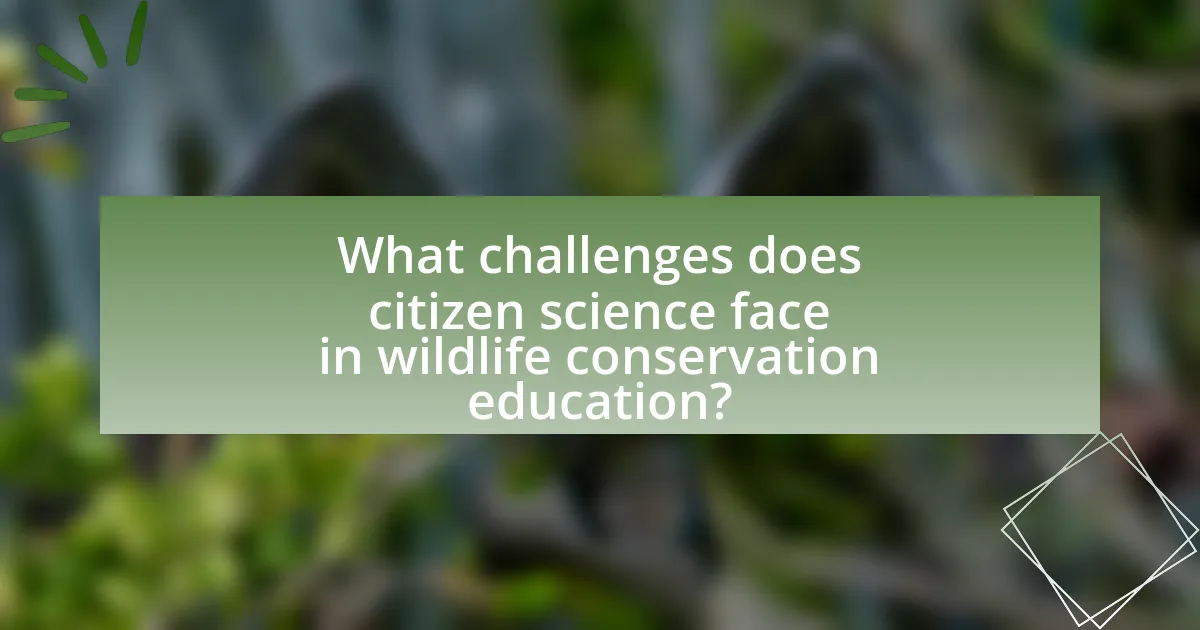
What challenges does citizen science face in wildlife conservation education?
Citizen science faces several challenges in wildlife conservation education, primarily including data quality, participant engagement, and resource limitations. Data quality issues arise from varying levels of expertise among volunteers, which can lead to inaccuracies in species identification and data collection. For instance, a study published in the journal “Biological Conservation” found that amateur observations often contain significant errors compared to expert assessments. Participant engagement can fluctuate, as maintaining motivation and interest among volunteers is difficult, particularly in long-term projects. Additionally, resource limitations, such as funding and access to training materials, hinder the effectiveness of citizen science initiatives. These challenges collectively impact the reliability and sustainability of citizen science efforts in wildlife conservation education.
How do data quality and reliability issues impact citizen science initiatives?
Data quality and reliability issues significantly undermine citizen science initiatives by compromising the accuracy and credibility of the data collected. When participants, who may lack formal training, contribute observations, inconsistencies and errors can arise, leading to unreliable datasets. For instance, a study published in the journal “Citizen Science: Theory and Practice” found that data quality varied widely among different projects, with some reporting error rates as high as 30%. This variability can hinder the effectiveness of wildlife conservation efforts, as decisions based on flawed data may lead to misallocation of resources or misguided conservation strategies. Therefore, ensuring high data quality and reliability is crucial for the success of citizen science initiatives in wildlife conservation education.
What strategies can be employed to ensure data accuracy in citizen science?
To ensure data accuracy in citizen science, implementing standardized protocols and training for participants is essential. Standardized protocols provide clear guidelines on data collection methods, which minimizes variability and enhances consistency across different contributors. Training sessions equip citizen scientists with the necessary skills and knowledge to accurately observe and record data, thereby reducing errors. Research indicates that projects employing structured training and clear methodologies report higher data quality, as seen in the study “The Role of Citizen Science in Data Quality” published in the journal “Citizen Science: Theory and Practice” by authors Bonney et al. (2014). Additionally, regular data validation processes, such as peer review or expert verification, further enhance the reliability of the collected data.
How can researchers address the challenges of participant engagement?
Researchers can address the challenges of participant engagement by implementing strategies that enhance motivation and accessibility. For instance, providing clear communication about the purpose and benefits of participation can significantly increase interest and commitment. A study by Bonney et al. (2014) in “Citizen Science: A Developing Tool for Expanding Science Knowledge and Engagement” highlights that when participants understand the impact of their contributions, they are more likely to remain engaged. Additionally, utilizing technology, such as mobile apps for data collection, can simplify participation and make it more appealing, as evidenced by the success of platforms like iNaturalist, which has increased user involvement in biodiversity monitoring.
What ethical considerations arise in citizen science for wildlife conservation?
Ethical considerations in citizen science for wildlife conservation include issues of data integrity, informed consent, and potential harm to wildlife. Data integrity is crucial as citizen scientists may lack the training to collect accurate data, which can lead to misleading conclusions about species populations or behaviors. Informed consent is essential when involving local communities, as they should be aware of how their contributions will be used and the potential impacts on their environment. Additionally, there is a risk of harm to wildlife if citizen scientists inadvertently disturb habitats or stress animals during data collection. These considerations highlight the need for guidelines and training to ensure ethical practices in citizen science initiatives.
How can citizen scientists ensure they are acting responsibly towards wildlife?
Citizen scientists can ensure they are acting responsibly towards wildlife by adhering to ethical guidelines and best practices in their research activities. This includes respecting wildlife habitats, minimizing disturbance to animals, and following local regulations regarding wildlife observation and data collection. For instance, the North American Bird Conservation Initiative emphasizes the importance of maintaining a safe distance from nesting sites to avoid stress on birds, which can lead to abandonment of nests. Additionally, citizen scientists should educate themselves about the species they study, understanding their behaviors and needs, which fosters responsible interactions and contributes to conservation efforts.
What guidelines should be followed to protect sensitive species during citizen science projects?
To protect sensitive species during citizen science projects, guidelines include minimizing disturbance, ensuring data confidentiality, and providing training for participants. Minimizing disturbance involves limiting access to critical habitats and avoiding sensitive periods such as breeding seasons. Ensuring data confidentiality protects the locations of sensitive species from potential harm, as publicizing such information can lead to poaching or habitat degradation. Providing training equips citizen scientists with the knowledge to identify sensitive species correctly and understand the importance of their conservation. These practices are supported by research indicating that responsible citizen science can enhance conservation efforts while safeguarding vulnerable species.
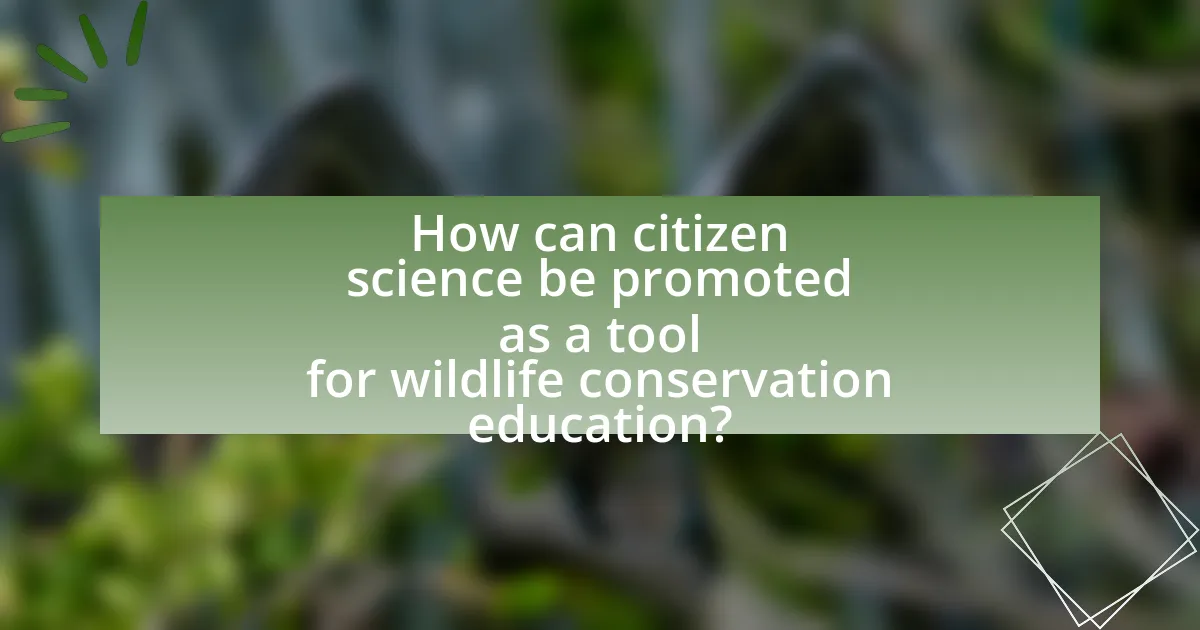
How can citizen science be promoted as a tool for wildlife conservation education?
Citizen science can be promoted as a tool for wildlife conservation education by integrating it into formal and informal educational programs. Educational institutions can incorporate citizen science projects into their curricula, allowing students to engage in real-world data collection and analysis, which enhances their understanding of ecological principles. For instance, programs like the Cornell Lab of Ornithology’s eBird initiative have successfully engaged thousands of volunteers in bird monitoring, demonstrating how citizen participation can contribute to scientific research while educating participants about biodiversity and conservation issues. Furthermore, community workshops and online platforms can facilitate citizen science participation, making it accessible to a broader audience and fostering a sense of stewardship towards local wildlife.
What role do educational institutions play in promoting citizen science?
Educational institutions play a crucial role in promoting citizen science by integrating it into their curricula and fostering community engagement. They provide students and the public with opportunities to participate in scientific research, enhancing their understanding of scientific methods and environmental issues. For instance, universities often collaborate with local organizations to create citizen science projects that involve data collection on biodiversity, which not only contributes to research but also raises awareness about wildlife conservation. Research shows that such initiatives can significantly increase public participation in science, as evidenced by programs like the Cornell Lab of Ornithology’s Project FeederWatch, which engages thousands of volunteers in bird monitoring, thereby contributing valuable data to ornithological studies.
How can curricula be developed to incorporate citizen science effectively?
Curricula can be developed to incorporate citizen science effectively by integrating hands-on, community-based projects that engage students in real-world scientific research. This approach allows students to collect data, analyze findings, and contribute to ongoing scientific efforts, fostering a deeper understanding of wildlife conservation. Research indicates that programs like the “Nature’s Notebook” initiative, which encourages participants to observe and record plant and animal phenology, have successfully enhanced student engagement and learning outcomes in environmental science education. By aligning curriculum objectives with citizen science projects, educators can create meaningful learning experiences that promote scientific literacy and environmental stewardship.
What partnerships can enhance citizen science initiatives in education?
Partnerships with universities, non-profit organizations, and government agencies can enhance citizen science initiatives in education. Universities can provide research expertise and resources, enabling students to engage in meaningful projects that contribute to scientific knowledge. Non-profit organizations often have established networks and outreach capabilities, facilitating community involvement and awareness. Government agencies can offer funding, regulatory support, and access to data, which can help in the implementation and sustainability of citizen science projects. For example, collaborations between educational institutions and organizations like the National Audubon Society have successfully engaged students in bird monitoring programs, demonstrating the effectiveness of such partnerships in promoting wildlife conservation education.
What are some successful examples of citizen science in wildlife conservation education?
Successful examples of citizen science in wildlife conservation education include the Cornell Lab of Ornithology’s eBird project, which engages birdwatchers to report bird sightings, contributing to a vast database that informs conservation efforts and research. Another example is the Monarch Watch program, where citizens tag and track monarch butterflies, providing critical data on migration patterns and population health. Additionally, the iNaturalist platform allows users to document biodiversity, aiding in species identification and conservation strategies. These initiatives demonstrate the effectiveness of citizen involvement in gathering data that supports wildlife conservation education and research.
How have specific projects made a measurable impact on wildlife conservation?
Specific projects have made a measurable impact on wildlife conservation by engaging communities in data collection and monitoring efforts, leading to increased biodiversity and habitat preservation. For instance, the Cornell Lab of Ornithology’s eBird project has mobilized over 100,000 citizen scientists to report bird sightings, resulting in a comprehensive database that informs conservation strategies and identifies critical habitats. This initiative has contributed to the protection of various bird species, evidenced by the identification of important migratory routes and breeding grounds, which are now prioritized for conservation efforts. Additionally, the Snapshot Serengeti project has utilized camera traps and citizen science to gather data on wildlife populations in Tanzania, revealing trends in species abundance and distribution that guide management decisions. These projects demonstrate how citizen involvement in scientific research can lead to significant advancements in wildlife conservation outcomes.
What lessons can be learned from successful citizen science initiatives?
Successful citizen science initiatives demonstrate the importance of community engagement and collaboration in wildlife conservation. These initiatives show that involving local communities not only enhances data collection but also fosters a sense of ownership and responsibility towards conservation efforts. For instance, the Great Backyard Bird Count, which engages thousands of participants annually, has generated valuable data on bird populations and migration patterns, highlighting the effectiveness of citizen involvement in scientific research. Additionally, successful initiatives often utilize accessible technology and clear communication strategies, making participation easy and informative, which further increases public interest and involvement in conservation efforts.
What practical steps can individuals take to get involved in citizen science for wildlife conservation?
Individuals can get involved in citizen science for wildlife conservation by participating in local biodiversity monitoring projects, contributing data to established platforms like iNaturalist or eBird, and volunteering with conservation organizations. Engaging in these activities allows individuals to collect and share valuable information about species distribution and behavior, which is crucial for conservation efforts. For instance, iNaturalist has over 1.5 million users who have contributed millions of observations, aiding researchers in tracking species trends and making informed conservation decisions. Additionally, attending workshops or training sessions offered by conservation groups can enhance skills in data collection and species identification, further empowering individuals to contribute effectively to wildlife conservation initiatives.
How can one find and participate in local citizen science projects?
To find and participate in local citizen science projects, individuals can utilize online platforms such as SciStarter, which aggregates various projects based on location and interest. These platforms provide detailed information about ongoing projects, including how to get involved, the type of data needed, and the expected commitment. Additionally, local universities, conservation organizations, and community groups often host citizen science initiatives, making it beneficial to check their websites or contact them directly for opportunities. Research indicates that citizen science projects can significantly enhance public engagement in wildlife conservation, as evidenced by studies showing increased participation rates when projects are easily accessible and well-promoted.
What resources are available for individuals interested in citizen science?
Individuals interested in citizen science can access a variety of resources, including online platforms, educational materials, and community organizations. Websites like SciStarter and Zooniverse provide databases of citizen science projects, allowing individuals to find and participate in initiatives that match their interests. Additionally, organizations such as the Citizen Science Association offer training resources and networking opportunities to enhance skills and collaboration among citizen scientists. Research indicates that participation in citizen science can significantly contribute to wildlife conservation efforts, as evidenced by studies showing increased public engagement and data collection efficiency in projects like the Great Backyard Bird Count.
